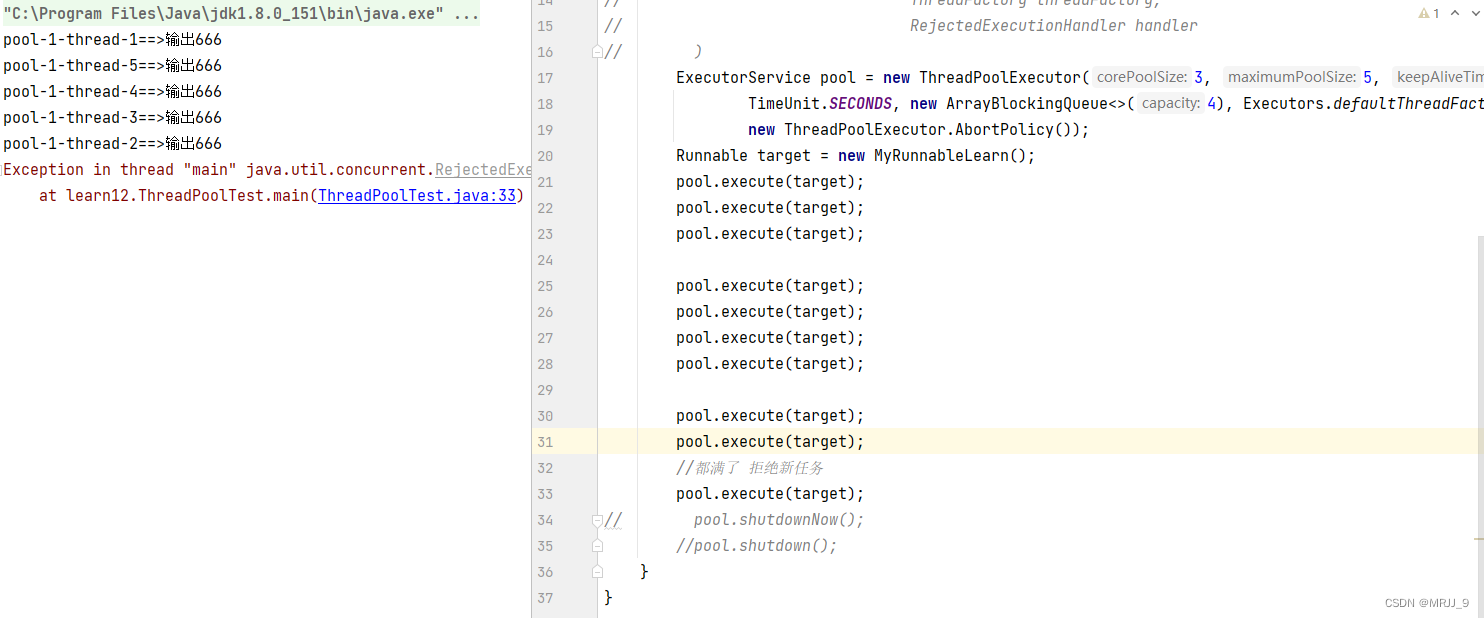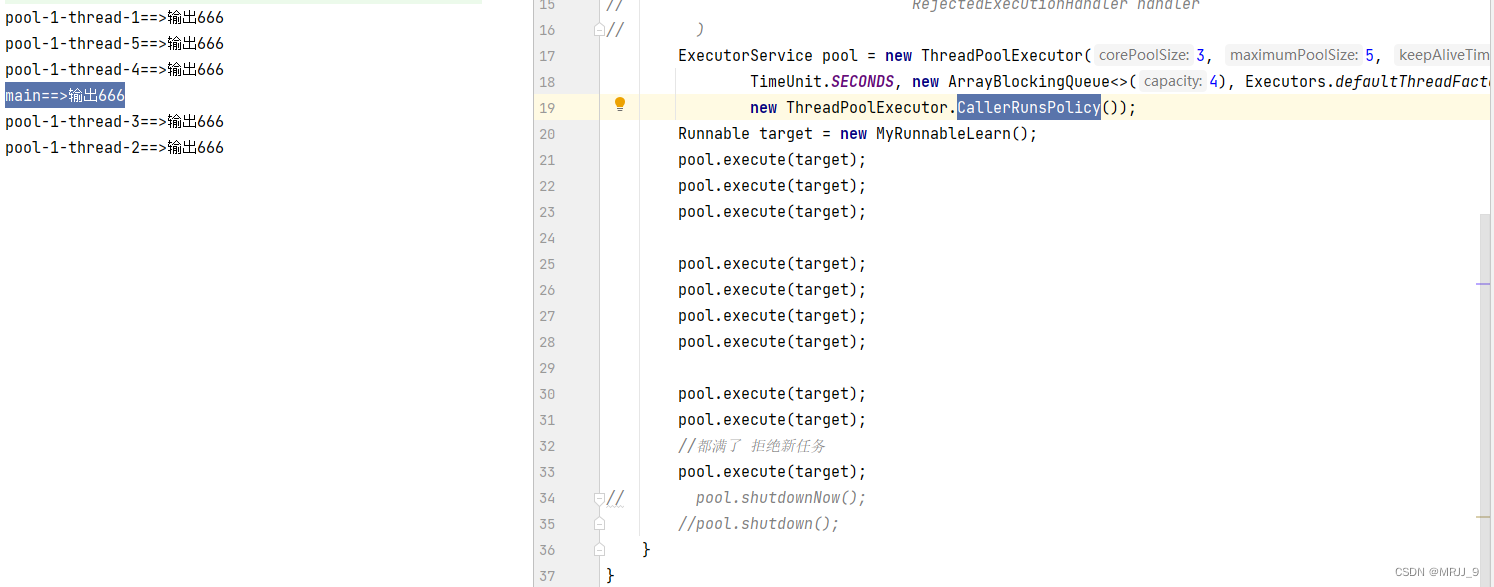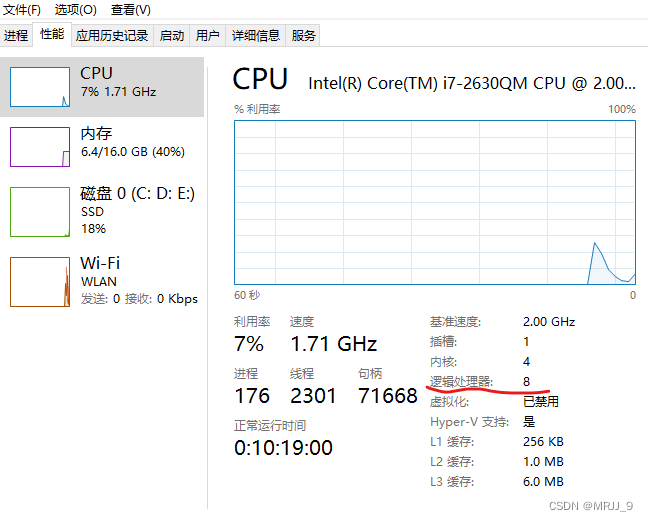前言:本博客主要涉及java编程中的线程、多线程、生成者消费者模型、死锁。
目录
线程多线程
创建一个简单的线程
获取执行当前代码的线程名:Thread.currentThread().getName()
开启线程:对象名.start()
守护线程 优先级
//1.创建一个继承于Thread类的子类
class MyThread extends Thread {
//2.重写Thread类的run()
@Override
public void run() {
for (int i = 0; i < 100; i++) {
System.out.println(Thread.currentThread().getName() + ":" + i);
}
}
}
public class ThreadTest {
public static void main(String[] args) {
MyThread t1 = new MyThread();
t1.start();
}
}package learn12;
class MyRunnable implements Runnable {
@Override
public void run() {
for (int i = 1; i <= 5; i++) {
System.out.println("子线程输出:" + i);
}
}
}
public class MyThreadTest2 {
public static void main(String[] args) {
Runnable target = new MyRunnable();
new Thread(target).start();
for (int i = 1; i <= 5; i++) {
System.out.println("主线程main输出:" + i);
}
}
}
线程安全
例子:多个人同时去一个账户里取钱,被取出后,不能再取出钱。但多个线程执行时,在访问时,账户里有钱的,但实际上已经被其他用户取走,此时再取钱就会引发数据不安全的问题。
使用多线程时,每个线程都对数据进行修改,如何来保证数据的安全性?
package learn12;
public class Account {
private String cardId;
private double money;
public Account() {
}
public Account(String cardId, double money) {
this.cardId = cardId;
this.money = money;
}
public String getCardId() {
return cardId;
}
public void setCardId(String cardId) {
this.cardId = cardId;
}
public double getMoney() {
return money;
}
public void setMoney(double money) {
this.money = money;
}
public void drawMoney(double money) {
String name = Thread.currentThread().getName();
if (this.money >= money) {
System.out.println(name + "来取钱" + money + "成功!");
this.money -= money;
System.out.println(name + "来取钱,此时剩余:" + this.money);
} else {
System.out.println(name + "来取钱,但余额不足");
}
}
}
package learn12;
public class DrawThread extends Thread {
private Account acc;
public DrawThread(Account acc, String name) {
super(name);
this.acc = acc;
}
@Override
public void run() {
acc.drawMoney(100000);
}
}package learn12;
public class ThreadTest {
public static void main(String[] args) {
Account acc = new Account("ICBC-100", 100000);
new DrawThread(acc, "小明").start();
new DrawThread(acc, "小红").start();
new DrawThread(acc, "小李").start();
}
}线程同步
使用了加锁的机制
synchronized
用到了同步控制关键字synchronized
用其修饰成员方法,被修饰的方法,在同一时间,只能被一个线程执行
//同步方法
public synchronized void drawMoney(double money) {
String name = Thread.currentThread().getName();
//同步代码块
synchronized (this) {
if (this.money >= money) {
System.out.println(name + "来取钱" + money + "成功!");
this.money -= money;
System.out.println(name + "来取钱,此时剩余:" + this.money);
} else {
System.out.println(name + "来取钱,但余额不足");
}
}
}Lock锁
注意:解锁要放在finally里,以便程序出错时,可以解锁。
package learn12;
import java.util.concurrent.locks.Lock;
import java.util.concurrent.locks.ReentrantLock;
public class Account {
private String cardId;
private double money;
//创建Lock锁对象
private final Lock lk = new ReentrantLock();
public Account() {
}
public Account(String cardId, double money) {
this.cardId = cardId;
this.money = money;
}
public String getCardId() {
return cardId;
}
public void setCardId(String cardId) {
this.cardId = cardId;
}
public double getMoney() {
return money;
}
public void setMoney(double money) {
this.money = money;
}
public void drawMoney(double money) {
String name = Thread.currentThread().getName();
//加锁
lk.lock();
try {
if (this.money >= money) {
System.out.println(name + "来取钱" + money + "成功!");
this.money -= money;
System.out.println(name + "来取钱,此时剩余:" + this.money);
} else {
System.out.println(name + "来取钱,但余额不足");
}
} catch (Exception e) {
e.printStackTrace();
} finally {
//解锁
lk.unlock();
}
}
}
线程通信
生产者线程负责生产数据
消费者线程负责消费生产者产生的数据
生产者消费者模型
package learn12;
import java.util.ArrayList;
import java.util.List;
public class Desk {
private List<String> list = new ArrayList<>();
public synchronized void put() {
try {
String name = Thread.currentThread().getName();
if (list.size() == 0) {
list.add(name + "做的肉包子");
System.out.println(name + "做了一个肉包子");
Thread.sleep(2000);
//唤醒别人 等待自己
this.notifyAll();
this.wait();
} else {
//唤醒别人 等待自己
this.notifyAll();
this.wait();
}
} catch (InterruptedException e) {
e.printStackTrace();
}
}
public synchronized void get() {
try {
String name = Thread.currentThread().getName();
if (list.size() == 1) {
System.out.println(name + "吃了:" + list.get(0));
list.clear();
Thread.sleep(1000);
//唤醒别人 等待自己
this.notifyAll();
this.wait();
} else {
//唤醒别人 等待自己
this.notifyAll();
this.wait();
}
} catch (InterruptedException e) {
e.printStackTrace();
}
}
}
package learn12;
public class ThreadTest4 {
public static void main(String[] args) {
Desk desk = new Desk();
//生产者线程
new Thread(() -> {
while (true) {
desk.put();
}
}, "厨师1").start();
new Thread(() -> {
while (true) {
desk.put();
}
}, "厨师2").start();
new Thread(() -> {
while (true) {
desk.put();
}
}, "厨师3").start();
//消费者线程
new Thread(() -> {
while (true) {
desk.get();
}
}, "吃货1").start();
new Thread(() -> {
while (true) {
desk.get();
}
}, "吃货2").start();
}
}
线程池
线程池就是一个可以复用线程的技术。
使用线程池的必要性:
用户发起一个请求,后台就需要创建一个新线程。不使用线程池,会产生大量的线程,会损害系统的性能。
线程池可以固定线程和执行任务的数量,可以避免系统瘫痪和线程耗尽的风险。
创建线程池
临时线程什么时候创建?
新任务提交时,发现核心线程都在忙,任务队列也满了,并且还可以创建临时线程,此时会创建临时线程。
什么时候可以拒绝新任务?
核心线程和临时线程都在忙,任务队列都满了,新的任务过来时才会开始拒绝任务。
使用线程池处理Runnable任务
package learn12;
public class MyRunnableLearn implements Runnable {
@Override
public void run() {
System.out.println(Thread.currentThread().getName() + "==>输出666");
try {
Thread.sleep(Integer.MAX_VALUE);
} catch (InterruptedException e) {
e.printStackTrace();
}
}
}package learn12;
import java.util.concurrent.*;
public class ThreadPoolTest {
public static void main(String[] args) {
//创建线程池对象
// new ThreadPoolExecutor(
// int corePoolSize,
// int maximumPoolSize,
// long keepAliveTime,
// TimeUnit unit,
// BlockingQueue<Runnable> workQueue,
// ThreadFactory threadFactory,
// RejectedExecutionHandler handler
// )
ExecutorService pool = new ThreadPoolExecutor(3, 5, 8,
TimeUnit.SECONDS, new ArrayBlockingQueue<>(4), Executors.defaultThreadFactory(),
new ThreadPoolExecutor.AbortPolicy());
Runnable target = new MyRunnableLearn();
pool.execute(target);
pool.execute(target);
pool.execute(target);
pool.execute(target);
pool.execute(target);
pool.execute(target);
pool.execute(target);
pool.execute(target);
pool.execute(target);
//都满了 拒绝新任务
pool.execute(target);
// pool.shutdownNow();
//pool.shutdown();
}
}


使用线程池处理Callable任务
package learn12;
import java.util.concurrent.Callable;
public class MyCallable implements Callable<String> {
private int n;
public MyCallable(int n) {
this.n = n;
}
@Override
public String call() throws Exception {
int sum = 0;
for (int i = 1; i <= n; i++) {
sum += i;
}
return Thread.currentThread().getName() + "求出了1-" + n + "的和是:" + sum;
}
}package learn12;
import java.util.concurrent.*;
public class ThreadPoolTest2 {
public static void main(String[] args) throws Exception {
ExecutorService pool = new ThreadPoolExecutor(3, 5, 8,
TimeUnit.SECONDS, new ArrayBlockingQueue<>(4), Executors.defaultThreadFactory(),
new ThreadPoolExecutor.CallerRunsPolicy());
//使用线程池处理Callbable任务
Future<String> f1 = pool.submit(new MyCallable(100));
Future<String> f2 = pool.submit(new MyCallable(200));
Future<String> f3 = pool.submit(new MyCallable(300));
//复用前面的线程
Future<String> f4 = pool.submit(new MyCallable(400));
System.out.println(f1.get());
System.out.println(f2.get());
System.out.println(f3.get());
System.out.println(f4.get());
}
} 
Excutors
大型并发系统环境中使用Excutors如果不注意可能会出现系统风险。
核心线程数
计算密集型任务:核心线程数量 = CPU核数+1
IO密集型任务:核心线程数量 = CPU核数*2
package learn12;
import java.util.concurrent.*;
public class ThreadPoolTest2 {
public static void main(String[] args) throws Exception {
//通过Executors创建一个线程池对象
ExecutorService pool = Executors.newFixedThreadPool(3);
Executors.newSingleThreadExecutor();
//使用线程池处理Callbable任务
Future<String> f1 = pool.submit(new MyCallable(100));
Future<String> f2 = pool.submit(new MyCallable(200));
Future<String> f3 = pool.submit(new MyCallable(300));
//复用前面的线程
Future<String> f4 = pool.submit(new MyCallable(400));
System.out.println(f1.get());
System.out.println(f2.get());
System.out.println(f3.get());
System.out.println(f4.get());
}
}悲观锁
一开始就加锁,每次只能一个线程进入访问完毕后,再解锁,线程安全,性能较差。
package learn12;
public class MyRunnable implements Runnable {
public int count;
@Override
public void run() {
for (int i = 0; i < 100; i++) {
System.out.println(this);
synchronized (this) {
System.out.println("count ===>" + (++count));
}
}
}
}
package learn12;
public class Test {
public static void main(String[] args) {
Runnable target = new MyRunnable();
for (int i = 1; i <= 100; i++) {
new Thread(target).start();
}
}
}乐观锁
一开始不上锁,等要出现线程安全问题时,等要出现线程安全问题时,线程安全,性能较好。
如何实现乐观锁
private AtomicInteger count = new AtomicInteger();
package learn12;
import java.util.concurrent.atomic.AtomicInteger;
public class MyRunnable implements Runnable {
private AtomicInteger count = new AtomicInteger();
@Override
public void run() {
for (int i = 0; i < 100; i++) {
System.out.println(this);
synchronized (this) {
System.out.println("count ===>" + count.incrementAndGet());
}
}
}
}并发VS并行
python进阶学习也涉及到这里的知识点。
进程:正在运行的程序
线程:一个进程中可以运行多个线程
并发:线程是由CPU调度执行的,但CPU能同时处理的线程数量有限,为了保证全部线程都能执行,CPU会轮询为系统的每个线程服务,由于CPU切换的速度很快,好像是线程在同时执行,这就是并发。
并行:同一时间点,任务同时地运行,比如一台电脑,有8个CPU,每个CPU的每个核心都可以独立地执行一个任务,在同一时间点,可同时执行8个任务,这时任务是同时执行,并行地运行任务。
线程的生命周期
New:新建
Runnable:可运行
Timinated:被终止
Timed Waiting:计时等待
Waiting:无线等待
Blocked:阻塞

























 15万+
15万+











 被折叠的 条评论
为什么被折叠?
被折叠的 条评论
为什么被折叠?










